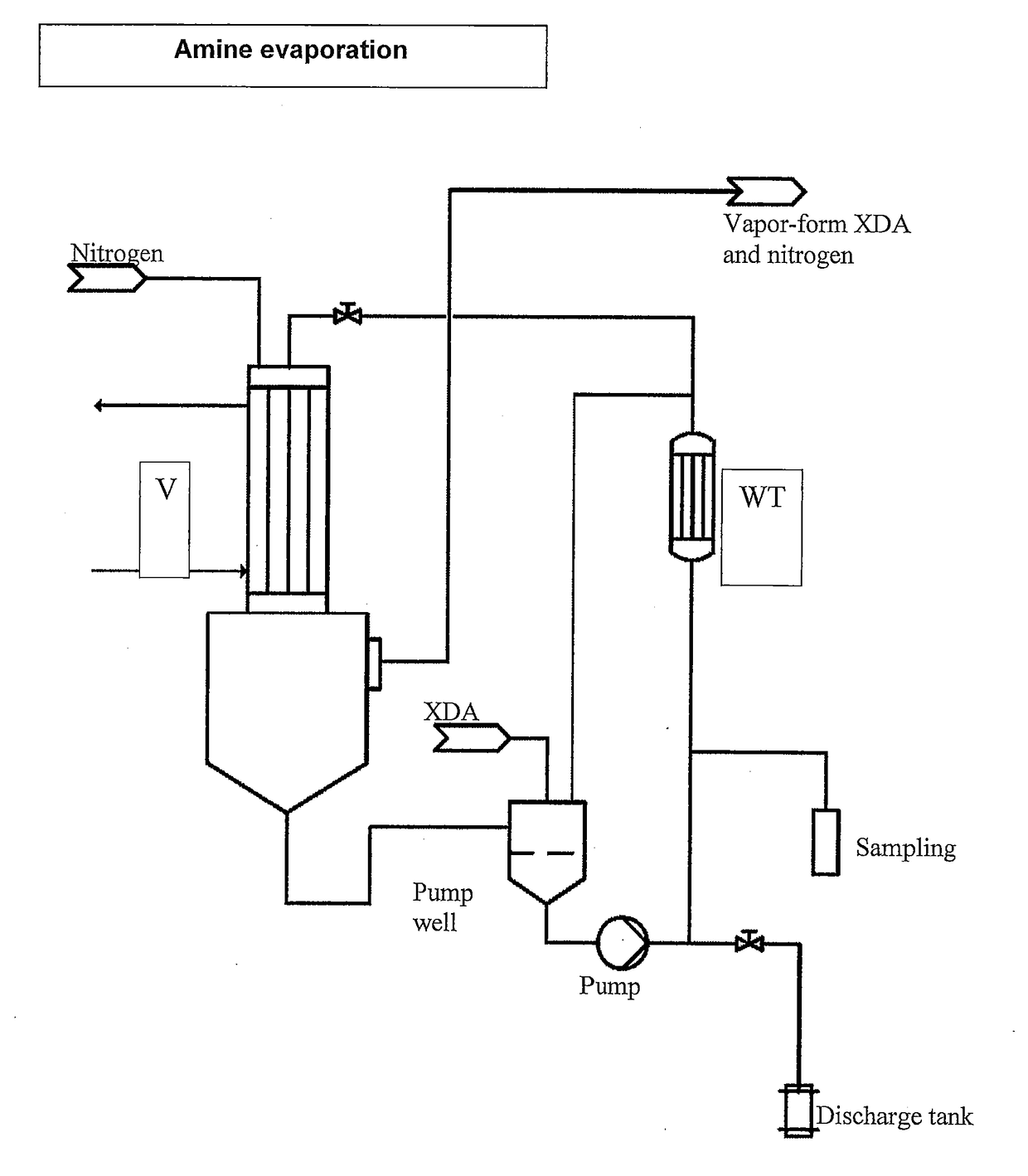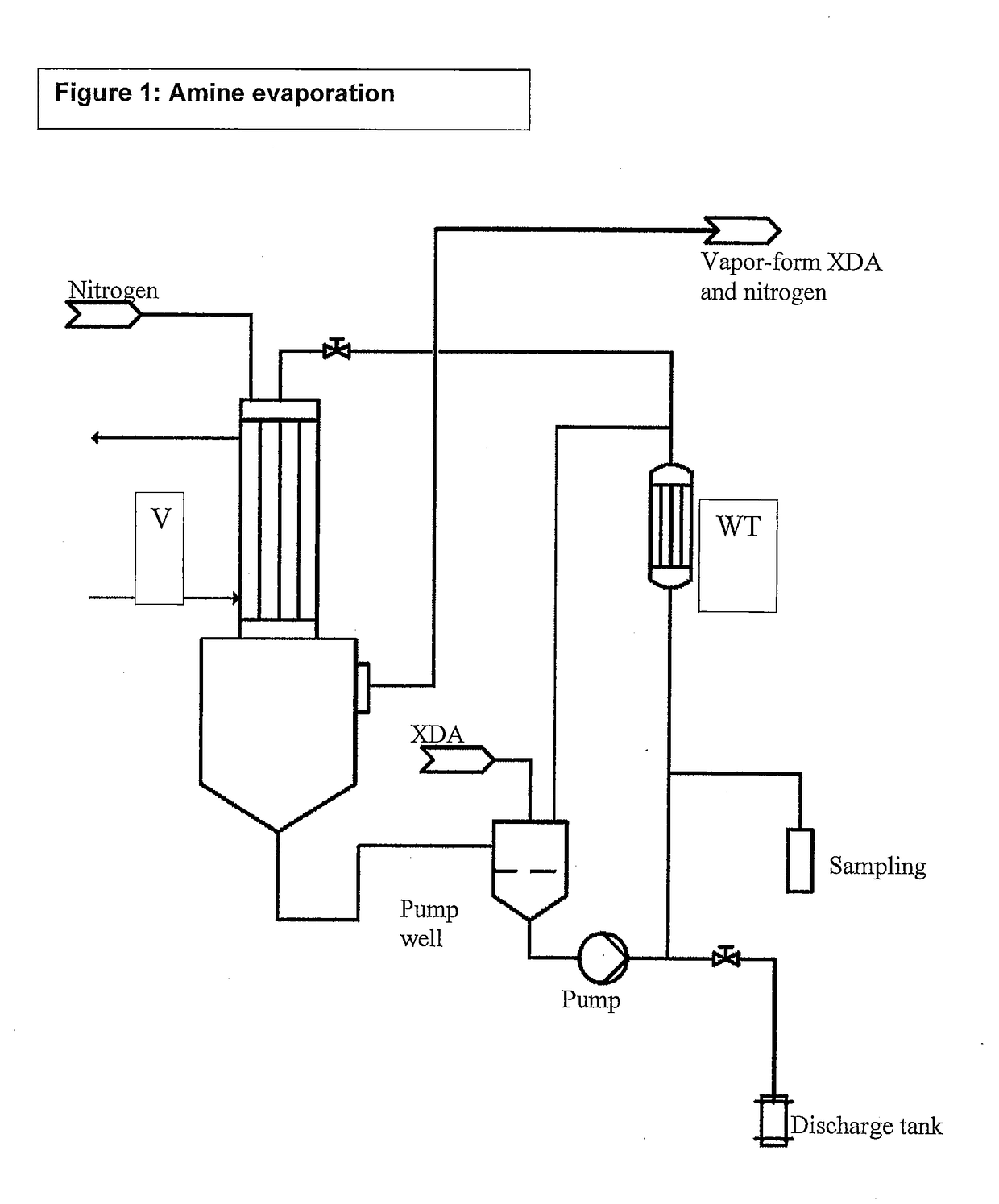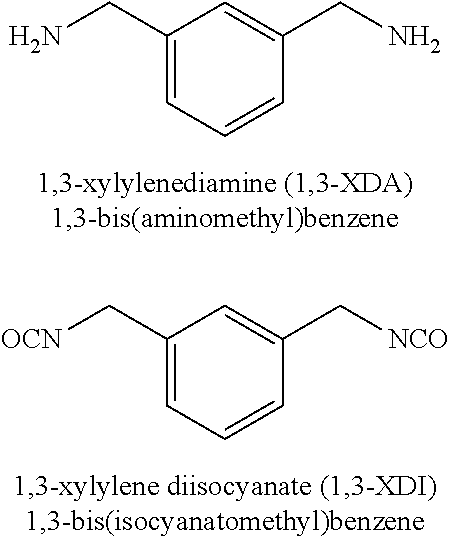Method for producing xylylene diisocyanates in the gaseous phase
- Summary
- Abstract
- Description
- Claims
- Application Information
AI Technical Summary
Benefits of technology
Problems solved by technology
Method used
Image
Examples
example 1 (
Inventive)
[0125]In a plant for gas-phase phosgenation with an amine evaporation stage in accordance with FIG. 1, a tubular reactor (L: 9350 mm, internal diameter 134.5 mm) having a coaxial nozzle (internal diameter 134.5 mm) arranged on the reactor axis, and a downstream isocyanate condensation stage, 200 kg / h of 1,3-XDA were vaporized continuously under a pressure of 650 mbar abs. with introduction of a nitrogen stream of 10 kg / h, the temperature in the pumping circuit (3200 kg / h) being held at 150° C. by cooling in a heat exchanger (WT). The pumping circuit was admixed beforehand with 500 ppm of TINUVIN 571. The admission temperature to the vaporizer (V) is 255° C., the entry temperature of the cooling medium into the heat exchanger (WT) is 40° C., and the mean residence time of the 1,3-XDA in the pumping circuit was 35 minutes. After leaving the vaporizer, the stream of gaseous 1,3-XDA and nitrogen was heated to 280° C. in a further heat exchanger, and supplied via the coaxial no...
example 2 (
Inventive)
[0126]In the plant described above, analogously, 160 kg / h of 1,3-XDA were vaporized under a pressure of 500 mbar abs. with introduction of a nitrogen stream of 4 kg / h, the temperature in the pumping circuit (3200 kg / h) being held at 150° C. by cooling in a heat exchanger (WT). The pumping circuit was admixed beforehand with 500 ppm of TINUVIN 571. The admission temperature to the vaporizer (V) is 240° C., the entry temperature of the cooling medium into the heat exchanger (WT) was 40° C., and the mean residence time of the 1,3-XDA in the pumping circuit was 43 minutes. The stream of gaseous 1,3-XDA and nitrogen was heated to 280° C. in a further heat exchanger, and supplied via the coaxial nozzle to the reactor. At the same time, in parallel, 500 kg / h of phosgene were heated to 310° C. and likewise supplied continuously to the reactor, at the annular space left free by the nozzle, the two reactant streams being mixed and reacted in the reactor. The rate of the gas flow in ...
example 4 (
Inventive)
[0130]2 kg of the XDI obtained in Example 2 were subjected to fractional distillation on a column. The first 500 g were discarded as an initial fraction; obtained as a main fraction are 1 kg of colorless 1,3-XDI. This main fraction was admixed at room temperature with 1.4 g of ZELEC UN (Steppan) and left to stand for 24 hours. The HC content of the sample, measured according to ASTM specification D4663-98 after distillation, was 105 ppm.
PUM
| Property | Measurement | Unit |
|---|---|---|
| Temperature | aaaaa | aaaaa |
| Temperature | aaaaa | aaaaa |
| Temperature | aaaaa | aaaaa |
Abstract
Description
Claims
Application Information
 Login to View More
Login to View More - R&D
- Intellectual Property
- Life Sciences
- Materials
- Tech Scout
- Unparalleled Data Quality
- Higher Quality Content
- 60% Fewer Hallucinations
Browse by: Latest US Patents, China's latest patents, Technical Efficacy Thesaurus, Application Domain, Technology Topic, Popular Technical Reports.
© 2025 PatSnap. All rights reserved.Legal|Privacy policy|Modern Slavery Act Transparency Statement|Sitemap|About US| Contact US: help@patsnap.com



